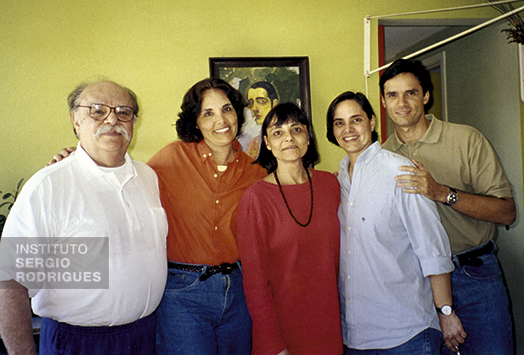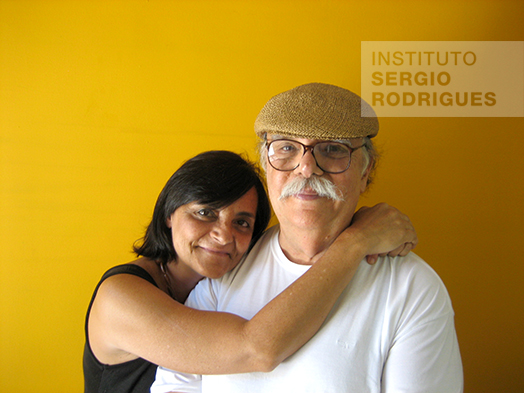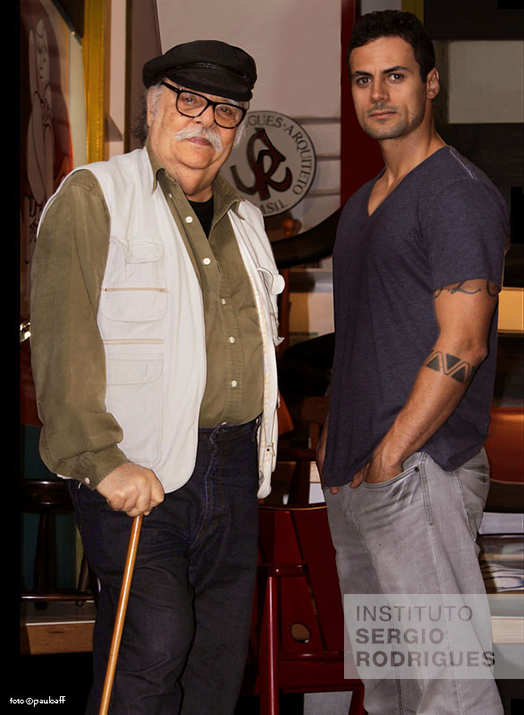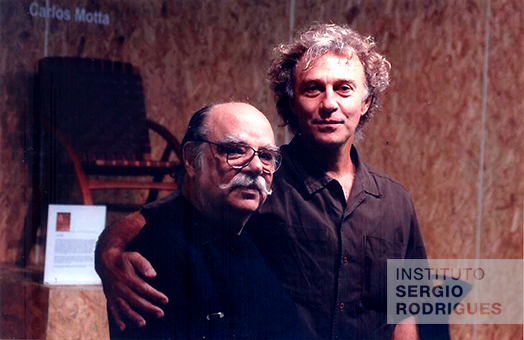Influenced by various creators, Sergio also left his mark on many Brazilian designers
Influenced by various creators, Sergio also left his mark on many Brazilian designers
The first contact Sergio had with modern furniture, while yet a college student, was with the creations of Joaquim Tenreiro, the Portuguese craftsman, carpenter, painter and sculptor who became famous in the furniture design field. Architect José Zanine Caldas’ industrialized furniture also caught his attention. Over and above being a landscape architect, Zanine was a furniture maker and sculptor. He used to make airplane plywood furniture that could be disassembled and was extremely simple, made in São Jose dos Campos, and Sergio had great admiration for him.
There were also models made by members of the so-call Italian artistic mission – for whom he had great admiration, such as Lina Bo Bardi, Giancarlo Palanti, Dominici, in lighting, and Carlo Hauner, with whom he had his first store, Móveis Artesanal Paranaense. Burle Marx was a major influence on prints and Lili Correia de Araújo, with her handmade fabrics.
In his early career, Sergio got mad when he was compared to some other designer. “I gradually became aware of things and realized that the influences of this or that architect were often portrayed,” he said in an interview to Casa e Jardim, in 1985.
During his São Paulo stage, surrounded by Italian partners, designers, and publications, those became his models. But the more he studied Scandinavian furniture, the more he realized that they had “more to do with our way of being.” “They were purer, and had not slid into superfluous fads.” In the same interview he said: “Today, I humbly realize the influence of Carlo Molino, from Turin, in the first desk I designed, although I never saw anything made by this architect. There is also something of Hans Wegner and Vito Latis in the little couch with a straw seat and back.”
But just as he was influenced by various creators, Sergio also left his mark on many Brazilian designers. The journalist Adélia Borges points a few out. “Sergio is very special, a very important figure in the Brazilian scenario, and was fortunate to have followers.” She says Sergio’s first followers started emerging in the 1980s, among whom Carlos Motta, in São Paulo, the designers of the Baraúna Joinery (Marcelo Ferraz and Francisco Fanucci, architects in SP), Claudia Moreira Salles (from Rio, but living in SP), and Mauricio Azeredo, in Goiás. It was a generation that emerged in the 1980s using a language that continued valuing wood as a Brazilian material par excellence and giving continuity to the research into what Brazilian furniture would be. Sergio led the way and planted the seeds for things that others followed. Fernando Mendes de Almeida is an important name as a follower, as is Zanini de Zanine.
Zanini took an internship with Sergio and was beside him when he produced his first piece of furniture, a collapsible coffee table with a wooden base and glass top. “Taking an internship with Sergio for a year was like going back to college, an amazing experience, not only to learn more about his work, but to get to know him closely,” said Zanini.
Sergio, in turn, paid tribute to his friend Zanine’s son: “Zanini de Zanine inherited all the artistic and artisan qualities, in addition to the moral and ethical virtues of his designer father. Zanininho, as I call him, served as an apprentice, but helped me as a veteran in my studio.”
Adélia Borges believes Sergio has a unique place that is his alone. “He continued when many others discontinued: Tenreiro drifted off into the fine arts, Zanine and Lina Bo Bardi stayed in architecture. Sergio, meanwhile, remained in the furniture area creating very significant things. In the 1950s, he created the Mocho stool, the Mole armchair, in the 1970s Kilin. He was very fertile over the decades. Today, he is seen as the most fertile Brazilian designer. Added to that is the amount, quality, and the very specific pursuit for the expression of the Brazilian culture in furniture. This gave him a unique position in the Brazilian scene.”
Fernando, on the path of the master
One of his “heirs,” Fernando Mendes was his main collaborator. When he arrived in Rio, coming from São Paulo, to study Industrial Design at the School of Fine Arts, Fernando Mendes attended a lecture by Sergio Rodrigues. He was fascinated by what he saw and heard. He was introduced to Sergio a few months later, approached the master, and started making discreet visits to his office. He soon fell in love with the Kilin chair and then realized that his career would be linked forever to drawing and wood. And, later, he discovered that Sergio was a cousin of his on Sergio’s mother’s side.
Admiration led him to draw near to Sergio, who invited him to work at his office. The first job I did for him was in 1986. It was a prefabricated house mockup. For exactly seven years, from 1993 to 2000, he worked with Sergio, with architecture on wood and later, from 2002, making custom handmade furniture for the office, at the time when Fernando was a partner at Mendes-Hirth. Then, in his own studio, Fernando join Sergio again. At first, he used to make furniture that was not in Lin Brasil’s industrial line, but after the contract with the factory was renewed, Fernando was given an award by his master: A license to manufacture 50 models of the collection of pieces created by Sergio, many of which as a relaunch of furniture that marked a period in the 1950s and 1960s.
A few pieces that had no commercial life because only one or two of them were created for customers in specific situations and were never made again will be reissued, for example, the Leif stool, that had been designed especially for a particular balcony. Other pieces, such as the Xibô and Tetê armchairs had prototypes completed years after they were created. These parts will be available on the market for the first time. The pieces were selected by the two and Fernando is gradually developing the production line.
While going through Sergio’s collection, Fernando also made new discoveries, such as a chair Sergio had forgotten about and for which there wasn’t even a prototype. It is now being manufactured at Fernando’s workshop, in São Cristóvão, named after its discoverer: The Fernando chair.
Fernando learned Sergio’s working method and developed a very unique way to work with him. “One time, Sergio was developing the project for Juarez Machado’s apartment, who wanted to have three chairs made for a tea table, but based on the existing model of the little Tajá seat. Sergio wanted to make a few changes, substitute a flat seat for a curved one, remove a crossmember there was below it, thin the tips of the feet a bit. And he gave tips on how to do that over the phone. I suggested increasing the crossmember of the seat to strengthen the chair. Anyway, we did it over the phone.” Based on the tips he got, Fernando understood what Sergio wanted. This chair, called Tajua (Ta because it was inspired by the Tajá chair, and Jua, for Juarez Machado), was made without a drawing. After it was ready, it was delivered straight to the customer, when Sergio saw it for the first time.
With the new mission of manufacturing Sergio’s furniture, Fernando put his dream of “creating and doing” into practice. “To me, there is an inseparable link between creating and doing.” To him, as for Sergio, knowledge of how to do is part of knowing how to design. “If some day I make a piece out of iron, I will have to visit a metalwork shop to learn how to cut, fold, which machine will be used, so on and so forth. A person may think about the plastic part, but does not know how the piece is made, so the docking solution, the ratio may be mistaken. If you take the arm of an Oscar, which is super delicate, full of nuances, relief, slots, hugely complex in terms of joinery, but if you know how to make it, you can imagine how you will develop it in each machine.”
Fernando learned a lot from Sergio by inventing his own style, but never stopped following the footsteps of his master in the passion for the craft of creating and making Brazilian furniture.

From left to right, Sergio Rodrigues next to his kids Ângela, Verônica, Adriana, and Roberto, at his home, in Rio de Janeiro, in the 2000s. In the background, self-portrait of Roberto Rodrigues, Sergio's father.

Verônica Rodrigues with her father, Sergio Rodrigues, in the 2000s.

Sergio Rodrigues with Zanini de Zanine Caldas, at his studio in Botafogo - Rio de Janeiro, in the 2000s.

Sergio Rodrigues with his friend and also designer, Carlos Motta.
